Francis Leopold McClintock, the ‘Arctic Fox’
Published in 18th–19th - Century History, Features, Issue 3 (May/Jun 2006), Volume 14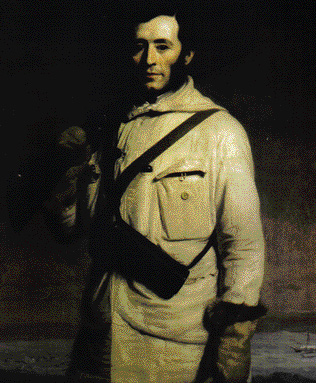
Sir Francis Leopold McClintock by Stephen Pierce. (National Portrait Gallery, London)
The last few years have seen a sudden resurgence of interest in the history of polar exploration, focused mainly on the major Antarctic expeditions of the early twentieth-century ‘heroic period’. Yet these expeditions represented the end of a long history of polar exploration, and twentieth-century explorers based their methods on the experiences of an earlier generation.
The fascination with the polar regions really began in 1818, when four Royal Navy ships were dispatched to the Arctic. The Isabella and the Alexander, commanded by Captain John Ross and Lieutenant William Parry, were sent to discover a navigable north-west passage. The other two ships, the Dorothea and the Trent, commanded by Captain David Buchan and Lieutenant John Franklin, were tasked with discovering the geographical North Pole. Both missions failed, but they represented the beginning of a long obsession with the Arctic on the part of both the Admiralty and the British public.
This was to be the first of many British polar expeditions, and throughout the nineteenth century further French, American and Russian expeditions sailed to the Arctic in the hope of reaching the North Pole or finding a north-west passage. The latter soon took prominence in the planning of these expeditions, as each nation sought to find a route from the Arctic Ocean into the Pacific. It was believed that such a route existed and that, by negotiating the islands and ice floes off the north-east coast of Canada, a channel to the Pacific could be found. It was thought that this would bring both commercial and strategic benefits. It was not until 1906 that Roald Amundsen finally completed a full transit to the Pacific, but he dismissed it as being of little practical value.
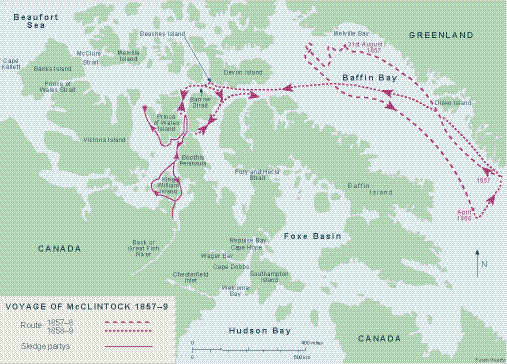
The route of the Fox between 1857 and 1859. Caught in the ice in Baffin Bay for nearly a year, the tiny ship was then swept southwards. McClintock and other land parties later headed west and explored King William Island, discovering traces of the missing Franklin expedition. (Sarah Gearty)
Several Irishmen played a prominent role in these early expeditions. Captain Henry Kellet from County Tipperary took part in two Arctic expeditions between 1848 and 1854. Captain Robert John McClure, born in Wexford, took part in three Arctic expeditions and would eventually travel from the Pacific to the Arctic Ocean during the Investigator expedition of 1850–3. He managed to complete a north-west passage, albeit by using two different ships and also sledging for a long distance. Captain F. R. M. Crozier from Banbridge travelled to both the Antarctic and the Arctic during the course of four expeditions between 1821 and 1848, only to disappear with the ill-fated Franklin expedition. Yet it was a Dundalk-born naval officer, Francis Leopold McClintock, who was to achieve the greatest fame and whose achievements would be remembered well into the twentieth century.
McClintock and the search for Franklin
Francis Leopold McClintock was born on 8 July 1819 at Seatown Terrace in Dundalk. He was one of the fourteen children of Henry McClintock, the town’s collector of customs, who had formerly been an officer in the 3rd Dragoon Guards. As a child he had little formal education and entered the Royal Navy as a gentleman volunteer in 1831, just before his twelfth birthday. He rose gradually through the ranks, being commissioned as a lieutenant in 1845. When his ship, the Gorgon, was beached off Montevideo, he distinguished himself in the salvage operations and thus gained further promotion. There was nothing in the early phase of his career to suggest that McClintock would break out of the normal naval routine. In 1848, however, he volunteered to take part in an expedition to search for the missing Franklin expedition. During the course of a series of Arctic searches, he went on to chart vast stretches of coastline, while also developing new methods for polar travelling. McClintock’s career as an explorer would, however, become entwined in the story of the missing Franklin expedition.
Sir John Franklin was one of the best-known explorers of the nineteenth century, having undertaken three Arctic expeditions between 1818 and 1827. After a controversial term as governor of Tasmania, he was given command of Erebus and Terror and, with Captain F. R. M. Crozier as his second-in-command, departed on his fourth Arctic expedition in the summer of 1845. Their mission was to finally discover a navigable north-west passage, and the two ships initially sailed in the company of some whalers before heading towards Lancaster Sound. Neither the Erebus nor the Terror, nor any of the 129 men of the crews, were ever seen again. During the course of the next twenty years over 50 land and sea expeditions would go in search of Franklin and his missing men.
McClintock’s first expedition was in 1848, when he travelled with Sir James Clark Ross aboard the Enterprise.
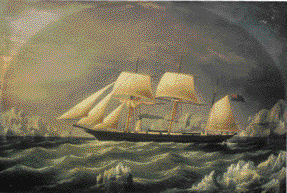
The Fox under full sail in the Arctic, artist unknown. (National Maritime Museum, Greenwich)
They searched the area around North Somerset and traveled to the south-west, to within 50 miles of Cape Bird. They found no trace of the missing expedition, but some years later McClintock came to realise that they had come very close to discovering the survivors, who were then heading in the direction of the Great Fish River. This 1848 expedition probably represented the only real hope of rescue that the survivors of the Franklin expedition ever had.
In the course of the next six years, he would serve on two further Arctic search expeditions aboard the Assistance (1850–1) and the Resolute (1852–4). He became increasingly frustrated as search parties scoured the coasts of Melville Island, Prince of Wales Land and Beechey Island. On Beechey Island they found the graves of three of Franklin’s crew, as well as sundry debris indicating that the expedition had passed that way. It was usual practice for all expeditions to deposit messages in stone cairns so that any subsequent search parties would have an indication of their planned route, but Franklin had failed to do this at Beechey Island. This left McClintock and his colleagues with no idea of in which direction to search.
The search expedition of 1852–4 was commanded by Sir Edward Belcher, who eventually ordered that four of the expedition’s ships be abandoned, including McClintock’s Resolute. When the members of this failed expedition returned to London, the Admiralty let it be known that there would be no further official search expeditions. There was a level of public protest, yet even the most optimistic felt it to be unlikely that there were any survivors.
In 1854 Dr John Rae of the Hudson Bay Company brought the first definite news of Franklin and his men. He had met parties of Inuit who told of how they had encountered the starving survivors as they trudged south-westwards towards the mouth of the Great Fish River.
Lady Franklin’s private expedition
Franklin’s wife, the redoubtable Lady Franklin, was determined that a proper search should be carried out of the islands off the mouth of the Great Fish River. By this time she realised that it was unlikely that any survivors would be found. She did hope, however, that some documentary records would be found and also that any remains of the crews could be afforded a Christian burial. The Admiralty refused to fund the expedition and she was forced to raise the funds herself. She contacted McClintock, who was kicking around Dublin on half-pay, and asked him for his advice. He helped her to obtain a ship, the Fox, and in April 1857 she offered him command of the expedition.
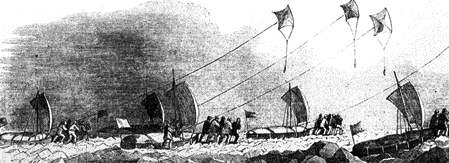
McClintock experimented with different means of improving sledge travel using kites and sails, methods that remained in use until the twentieth century.
He accepted the offer with alacrity and assembled a small crew, which included Dr David Walker from Belfast, who would serve as ship’s surgeon, naturalist and photographer. The Fox was a tiny steam yacht of just 177 tons, but McClintock was by now an expert in Arctic navigation. After a frustrating year locked in the ice off Greenland, he finally reached the coast of Boothia in 1858 and sent a number of search parties ashore. He was convinced that he was searching in the right area, and during the course of overland expeditions to King William Island and towards the Great Fish River his men found debris and some bodies of the crew of the Franklin expedition.
Finally, another of the Fox’s officers, Lt William R. Hobson, found the written record left by some of Franklin’s officers at Victory Point on King William Island. The initial entry told of the progress of the expedition up to May 1847:
‘28th of May 1847
H.M. ships Erebus and Terror wintered in the ice in Lat. 70º 5’ N., Long. 98º 23’ W. Having wintered in 1846–7 at Beechey Island in Lat. 74º 43’ 28” N., Long. 91º 39’ 15” W., after having descended Wellington Channel to Lat. 77º and returned by the West side of Cornwallis Island. Sir John Franklin commanding the expedition. All well. Party consisting of 2 officers and 6 men left the ships on Monday 24th May 1847.
Gm. Gore, lieut.
Chas. F. Des Voeux, Mate’
To this original message a postscript had been added in April 1848. It told of a rapid deterioration in the condition of both the ships and men. The two ships had been beset and the men had begun to fall ill. In the space of less than a year, the optimistic tone of the original message had been replaced by a postscript message that was heavy with foreboding:
‘25th April 1848
H.M. ships Terror and Erebus were deserted on the 22nd April, 5 leagues NNW of this, having been beset since 12th Septr 1846. The officers and crews consisting of 105 souls, under the command of Captain F.R.M. Crozier landed here, in Lat. 69º 37’ 42”, Long. 98º 41’ . . . Sir John Franklin died on the 11th June 1847 and the total loss by deaths in the expedition has been to date 9 officers and 15 men.
James Fitzjames, Captain HMS Erebus
F.R.M. Crozier, Captain and Senior offr.
and start on tomorrow 26th for Back’s Fish River.’
This documentary evidence, combined with the bodies and debris that McClintock and his men had found, left no doubt as to the fate of Franklin and his men. In 1848, the combined crews of the Erebus and the Terror had set off in the direction of the Great Fish River. Short of supplies, they had died during this march southwards.
On his return in 1859 McClintock was lauded as a hero, much to his own surprise. He had expected the public to react badly to the grim news that he brought with him, but instead he was fêted as the discoverer of the fate of the Franklin expedition. Later in 1859 he published an account, The voyage of the Fox, which soon ran to several editions.
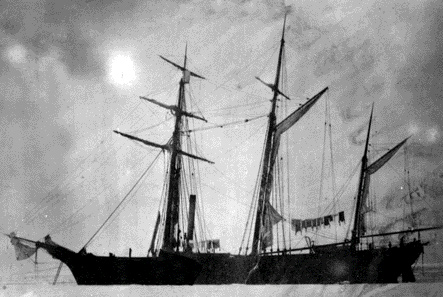
Surveyor, botanist, zoologist and photographer
Today McClintock is hardly remembered at all outside a small community of polar historians. For most, his greatest achievement was to finally discover concrete evidence of Franklin’s fate. His career was of much greater scientific significance, however. During the course of his four Arctic expeditions he surveyed and charted vast areas of unknown Arctic coastline. He explored North Somerset, King William Island, Melville Island and Prince Patrick Island, among others. He discovered the Polynia Islands and also a navigable north-west passage, pushing back the boundaries of geographical knowledge by surveying many of the large ‘blank’ spaces on the Admiralty’s charts of the Arctic.
Despite his poor childhood education, he had read widely on subjects such as botany and zoology. He combined this self-taught knowledge with a natural sense of curiosity and amassed a vast collection of zoological and fossil specimens, many of which were new to science. Indeed, McClintock’s collection was so vast that he had to abandon some of his specimens in caches in the Arctic. One of these caches was discovered by a Canadian expedition in 1960. Today the largest collection of these specimens is held in the Natural History Museum in Merrion Square, Dublin.
McClintock also dabbled in photography, which was then in its infancy. Using a primitive calotype, he took several portraits and some landscape photographs during his third expedition of 1852–4. Many of these are now lost, but some survive in a private collection. One of the pieces of equipment that he insisted on taking aboard the Fox was another camera apparatus, and this was put in the care of the ship’s surgeon, Dr David Walker. In this way McClintock played a small but significant role in the development of polar photography.
Father of modern sledging technique
His most significant contribution came in the area of sledge travel. On all of his expeditions he went on overland journeys, and these become longer and more epic as his experience increased. During the Fox expedition, he was away from the ship for over 90 days, traveling 920 miles and surveying 800 miles of new coastline. By this time he had developed a sophisticated system for sledge travelling, using support teams and a depot system. On some occasions he also used kites and sails to assist the sledge teams. Owing to the success of his overland expeditions he became an acknowledged expert on polar travel, and came to be known as the father of modern sledging technique. While his methods represented a great leap forward in methods of polar travel, his teams used the most basic equipment and clothing. The hardships they endured in sub-zero temperatures were extreme, and he later described his experiences in a series of articles for the Journal of the Royal Dublin Society and also in his Voyage of the Fox. Of his 1853 sledging expedition to Melville Island, he later wrote:
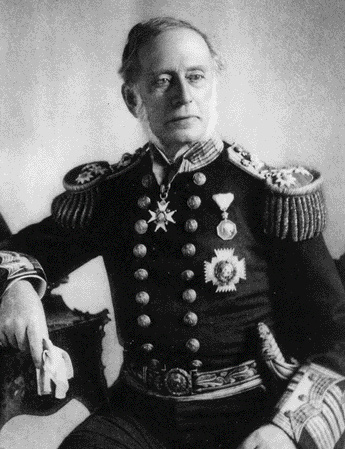
McClintock in retirement as a full admiral.
‘4th July. Midnight. Halted to lunch. These halts are always disagreeable. At the commencement of our journey we were obliged to keep moving about to prevent our feet being frost-bitten, whilst we got through a few mouthfuls of frozen bacon as dexterously as we could, with huge mitts on. At this season we have also to keep moving about, to prevent our feet getting benumbed, which they are always too ready to do after walking several hours through the ice-cold water; and just now our upper garments, which have escaped the splashing, are saturated by four hours rain. Under all circumstances we have one unfailing comfort, in the welcome drop of grog, which constitutes the only enjoyable part of our nightly luncheons.’
His techniques had other long-term ramifications. Although he had used dog teams with some success, he preferred to use man-haulage, and his advocacy of these methods caused them to be retained well into the twentieth century. By this time other expeditions, especially the Norwegians, were using dog teams with considerable success. By surviving his contemporaries, he had lived to become the recognised expert on polar exploration in British circles. He acted as advisor on the Nares expedition of 1875–6 and also on the British Antarctic expedition of 1902–4. In this capacity he sat on the design committee for the Discovery and was consulted by Captain R. F. Scott about sledging methods. In 1902 Roald Amundsen also visited him, although Amundsen later claimed that he did so out of courtesy, as he had already formed his own opinions on polar travel.
After the Fox expedition McClintock returned to regular naval duties and held a number of appointments, including admiral-superintendent of Portsmouth dockyard and commander-in-chief of the North American and West Indies Station; he also served as a naval ADC to Queen Victoria. He remained active in various scientific and geographical societies, such as the Royal Dublin Society, the Royal Geographical Society and the Royal Irish Academy, often giving lectures on the polar regions. In 1868 he stood for election as a (Conservative?) candidate for Drogheda, but withdrew after large-scale electoral rioting. In 1884 he retired as a full admiral, and died in London on 17 November 1907. He was buried in Kensington cemetery. A memorial plaque was later unveiled in Westminster Abbey. Predictably, it described him as ‘the discoverer of the Fate of Franklin’.
Indeed, the Franklin legend has continued to endure. Every year exploring parties venture into the Canadian Arctic in search of more human remains or discarded equipment from the expedition. As late as the 1990s, the remains of a boat and some skeletons were discovered on an island in Erebus Bay. The Irish explorer John Murray carried out a series of magnetic surveys off King William Island in 2003 and believes that he has discovered the remains of the Erebus and the Terror.
McClintock will continue to be associated with the missing Franklin expedition. In many ways this is appropriate as he went to such efforts to find evidence of the missing men. Yet the Franklin searches represent only one aspect of his career. Throughout his expeditions he went to great lengths to push back the boundaries of scientific and geographical knowledge. The fact that his sledging methods were retained into the twentieth century has drawn some criticism. Yet over some terrain these methods are still of practical use. Many modern expeditions have resorted to man-haulage when travelling over ridged and hummocked ice, the kind of terrain where dog teams cannot travel. McClintock made many worthwhile discoveries during his expeditions in the Arctic and these were both practical and scientific. It is for this reason that he stands out as Ireland’s most important polar explorer of the nineteenth century.
David Murphy is currently compiling a gazetteer of Irish regiments for the
Military Heritage Trust of Ireland.
Further reading:
F. Fleming, Barrow’s boys (London, 1998).
D. Murphy, The Arctic Fox: Francis Leopold McClintock, discoverer of the fate of Franklin (Cork and Toronto, 2004).
F. Nugent, Seek the frozen lands (Cork, 2003).
A. Savours, The search for the North West Passage (London, 1999).
















